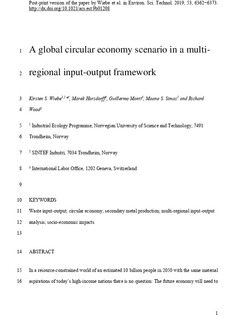| dc.contributor.author | Wiebe, Kirsten Svenja | |
| dc.contributor.author | Harsdorff, Marek | |
| dc.contributor.author | Montt, Guillermo | |
| dc.contributor.author | Silva Simas, Moana | |
| dc.contributor.author | Wood, Richard | |
| dc.date.accessioned | 2019-12-05T12:27:38Z | |
| dc.date.available | 2019-12-05T12:27:38Z | |
| dc.date.created | 2019-06-18T11:22:30Z | |
| dc.date.issued | 2019 | |
| dc.identifier.citation | Environmental Science and Technology. 2019, 53 (11), 6362-6373. | nb_NO |
| dc.identifier.issn | 0013-936X | |
| dc.identifier.uri | http://hdl.handle.net/11250/2631972 | |
| dc.description.abstract | In a resource-constrained world of an estimated 10 billion people in 2050 with the same material aspirations of today’s high-income nations, there is no question: The future economy will need to be circular. From a policy perspective, the question is whether averting catastrophic environmental impacts through an accelerated transition to a global circular economy can also deliver sustained growth and jobs. The adoption of circular economy measures will have a range of effects on both domestic and foreign supply chains. Multiregional input–output (MRIO) analysis models the interdependencies between industries and within and between countries as well as between intermediate and final goods producers and consumers. It provides a useful toolbox for assessing social, environmental, and economy-wide impacts of the adoption of the circular economy. We project the MRIO database EXIOBASE to 2030 on the basis of the exogenously given parameters of the International Energy Agency’s Energy Technology Perspective (IEA ETP) 6-degree scenario. We compare this business-as-usual (BAU) scenario and an alternative circular economy scenario. The circular economy scenario considers more recycling, reducing (material efficiency increase), repair, and reuse in relation to the BAU scenario. The adoption of circular economy measures has diverse impacts on the economy and environmental pressures. Global material extraction is reduced by about 10% compared to the baseline, while the impact on employment is small but positive. In particular, the shift from resource extracting sectors to the service sector will provide more opportunities for high-skilled and female workers. | nb_NO |
| dc.language.iso | eng | nb_NO |
| dc.publisher | American Chemical Society | nb_NO |
| dc.title | Global Circular Economy Scenario in a Multiregional Input-Output Framework | nb_NO |
| dc.type | Journal article | nb_NO |
| dc.type | Peer reviewed | nb_NO |
| dc.description.version | acceptedVersion | nb_NO |
| dc.source.pagenumber | 6362-6373 | nb_NO |
| dc.source.volume | 53 | nb_NO |
| dc.source.journal | Environmental Science and Technology | nb_NO |
| dc.source.issue | 11 | nb_NO |
| dc.identifier.doi | 10.1021/acs.est.9b01208 | |
| dc.identifier.cristin | 1705615 | |
| dc.description.localcode | Locked until 3.5.2020 due to copyright restrictions. This document is the Accepted Manuscript version of a Published Work that appeared in final form in [Environmental Science and Technology ], copyright © American Chemical Society after peer review and technical editing by the publisher. To access the final edited and published work see http://dx.doi.org/10.1021/acs.est.9b01208 | nb_NO |
| cristin.unitcode | 194,64,25,0 | |
| cristin.unitname | Institutt for energi- og prosessteknikk | |
| cristin.ispublished | true | |
| cristin.fulltext | original | |
| cristin.qualitycode | 2 | |
